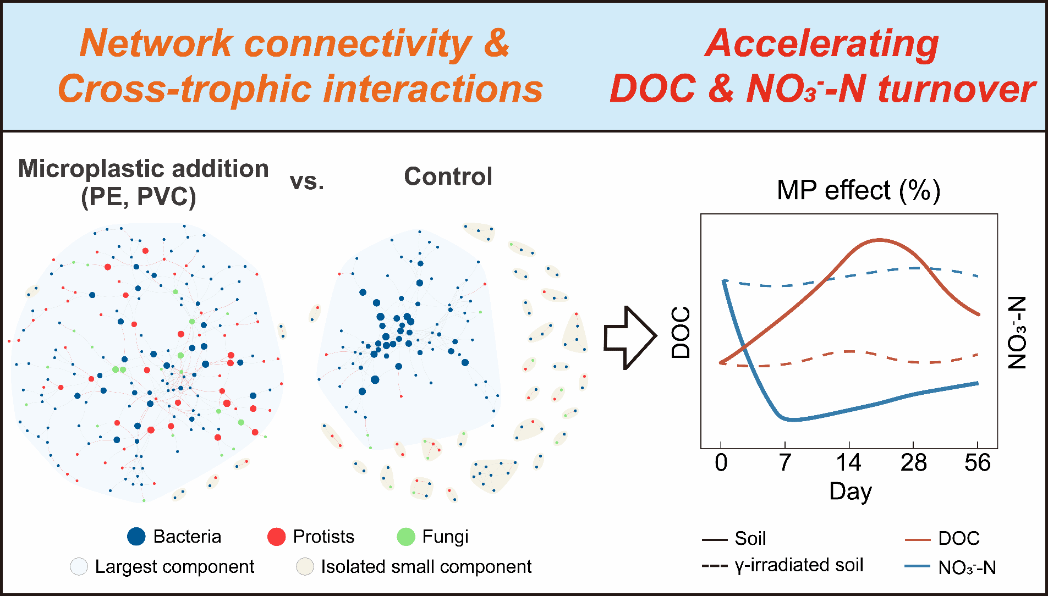南湖新闻网讯(通讯员 高胜寒)近日,我校资源与环境学院黄巧云教授团队在Environmental Science & Technology发表题为“Microplastics trigger soil dissolved organic carbon and nutrient turnover by strengthening microbial network connectivity and cross-trophic interactions”的研究论文,该研究阐明了农田土壤微塑料污染通过重塑微食物网结构驱动养分周转的级联机制,为解析农田土壤微塑料污染的环境生态效应提供了方法和理论支撑。
地膜覆盖、污泥施用等农业活动使得农田土壤成为微塑料重要的汇,微塑料进入土壤后形成独特的“塑料际”,进而改变土壤微生物的种间互作与代谢功能,影响土壤养分的周转平衡,对农田生态系统的可持续性构成潜在威胁。在农田生态系统中,由细菌、真菌、原生生物等构成的土壤微食物网,是土壤中物质循环和能量流动最为活跃的组分,驱动着土壤有机碳周转、养分循环等众多生态过程。然而,目前研究主要聚焦单一微生物类群对微塑料污染的响应,缺乏对于“微塑料-微食物网-养分循环”级联调控过程的机制解析。
研究团队通过微宇宙模拟结合土壤灭菌实验,追踪了农田土壤典型微塑料污染后微生物群落演替与土壤养分周转动态,发现微塑料输入导致土壤可溶性有机碳含量激增,类腐殖酸组分显著富集,但硝态氮含量急剧下降,引发了“微塑料诱导的土壤激发效应”。尽管微食物网中细菌、真菌和原生生物对不同类型/浓度微塑料的响应存在差异,微塑料却一致地塑造了连通紧密和交互复杂的微生物多营养级“社交网络”,网络连通度和跨营养级互作强度较未污染土壤上升了2-5倍。网络连接度和跨营养级互作是驱动微塑料污染下土壤可溶性有机碳释放和养分周转失衡的关键因素,其重要性超过单一营养级微生物多样性、酶活及碳氮循环功能基因丰度。丝足虫类、纤毛虫类等原生生物作为网络的“关键连通枢纽”,在串联多营养级模块和强化网络连通度方面发挥重要作用。灭菌土壤中微塑料对碳氮的影响几乎消失,进一步证明了微生物过程的核心驱动作用。该研究揭示了微塑料污染通过重塑土壤微食物网结构影响土壤有机碳分解和养分流失的作用机制,为深入理解全球变化背景下的生物地球化学循环提供了新视角。

图1 微塑料污染下微食物网多营养级互作对于土壤碳氮循环过程的调控
华中农业大学博士研究生高胜寒为论文第一作者,郝秀丽副教授为通讯作者,黄巧云教授、陈雯莉教授和刘玉荣教授等参与了该项研究工作。该研究获得了国家自然科学基金等项目的资助。
审核人 郝秀丽
【英文摘要】
Increasing microplastic (MP) inputs in agricultural soils have gained global attention for their ecological effects, especially on soil organic carbon (SOC) and nutrient turnover. However, the microbial mechanism underlying MP-induced SOC and nutrient dynamics remains poorly understood. Here, we investigated the impacts of two common MPs (polyethylene and polyvinyl chloride) on microbial hierarchical groups (bacteria, fungi, and protists) and the cascading effects on dissolved organic carbon (DOC) and nutrient dynamics in two typical agricultural soils (Mollisol and Ultisol). Our results showed that MP inputs consistently reduced NO3–-N concentration but increased the content of DOC and specific dissolved organic matter (DOM) components. Despite divergent responses of microbial hierarchical groups to MPs, MP inputs consistently strengthened the connectivity and cross-trophic associations of microbial multitrophic networks. Protistan nodes belonging to Cercozoa, Ciliophora, and Chlorophyta played essential roles in maintaining network connectivity in MP-treated soils. The enhanced network connectivity and cross-trophic associations primarily explained variations in soil DOC and nutrient turnover. These findings collectively indicate that MP inputs trigger DOC and nutrient turnover by enhancing the potential multitrophic interactions and species connectivity within soil micro-food webs. Our study provides novel insights into the ecological consequences of MP pollution on microbial hierarchical interactions and microbially mediated biogeochemical cycling.
论文链接:https://pubs.acs.org/doi/10.1021/acs.est.4c12546